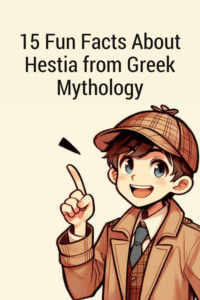Greek mythology is a treasure trove of fascinating stories and characters, and Gaia is certainly one of the most intriguing figures in this rich tapestry of ancient tales. Often referred to as Mother Earth, Gaia plays a vital role in the creation and evolution of the Greek cosmos. In this article, we’ll delve into 15 fun facts about Gaia, unveiling her significance, her many roles, and her intriguing interactions with other gods and goddesses.
Fact 1: Gaia’s Origins
- Birth of Gaia: Gaia, born from Chaos, was the very first deity in the Greek cosmogony. She emerged as the embodiment of the Earth itself, and everything in it.
- Mother of Titans: Gaia was the mother of the Titans, the giants who preceded the Olympian gods, including famous figures like Cronus and Rhea.
- Elemental Power: Her essence was the earth, the very ground beneath our feet, and this made her a pivotal force in Greek mythology.
Fact 2: Gaia’s Role in Creation
- Mother of Everything: Gaia gave birth to Uranus (the sky) and Pontus (the sea), completing the triad that formed the foundation of the Greek cosmos.
- Generative Force: She played a crucial role in the creation of all life forms and elements on Earth, making her the ultimate mother figure.
- Fertile Ground: Gaia’s role as the Earth itself meant that she provided the fertile ground for all life to flourish.
Fact 3: Mother of Giants
- Giants’ Origins: Gaia was the mother of the Gigantes, the famous giants who rebelled against the Olympian gods.
- The Gigantomachy: This rebellion led to the epic battle known as the Gigantomachy, where the Olympians fought the giants to maintain their rule over the cosmos.
- Defender of Her Offspring: Gaia was known to support her children, even when they clashed with the more powerful Olympian gods.
Fact 4: Gaia and Uranus
- Marriage to Uranus: Gaia was married to Uranus, who was her son as well as her husband, reflecting the complexity of Greek mythology.
- Divine Offspring: Together, Gaia and Uranus gave birth to the first generation of Titans, who would go on to play significant roles in Greek mythology.
- The Separation: Gaia and Uranus’ relationship was tumultuous, leading to their eventual separation, which had profound consequences.
Fact 5: The Titans
- Prominent Offspring: Gaia’s children, the Titans, included notable figures like Cronus, Rhea, and Atlas, who held pivotal roles in the Greek pantheon.
- Titanomachy: The Titans would later wage war against the Olympian gods, leading to the Titanomachy, a grand battle that would shape the destiny of the cosmos.
- Influence Over Nature: Many Titans were associated with natural elements, symbolizing Gaia’s connection to the Earth’s forces.
Fact 6: Gaia’s Vengeance
- Tartarus Creation: Gaia’s anger and desire for revenge led her to create Tartarus, the deepest pit of the underworld, to imprison her unruly offspring, the Titans.
- Cyclopes and Hecatoncheires: Gaia also bore the Cyclopes and the Hecatoncheires, who would later become instrumental in the battle against the Titans.
- A Divine Mother’s Wrath: Her fury and determination made her a force to be reckoned with in the world of gods and titans.
Fact 7: Gaia and Motherhood
- Mother of All: Gaia’s title as “Mother Earth” reflects her role as the ultimate nurturer, providing life, sustenance, and support to all living beings.
- Nurturing All Creatures: She watched over animals, plants, and even humans, ensuring that the circle of life continued.
- Eternal Connection: Gaia’s eternal connection with the Earth made her a beloved and respected figure in Greek mythology.
Fact 8: Gaia’s Prophecies
- Oracles of Gaia: Gaia was known for her prophetic abilities. She was often consulted for her wisdom and insights into the future.
- Influence on Fate: Her prophecies had a direct impact on the destinies of many heroes and gods, shaping the course of their lives.
- Oracle of Delphi: Gaia was one of the oracles at Delphi, a sacred site where many sought her guidance.
Fact 9: Gaia’s Associations
- Mother and Grandmother: Gaia was both the mother of the Titans and the grandmother of many well-known Olympian gods, forging strong family ties in Greek mythology.
- Fertility and Abundance: She was closely associated with the concept of fertility and abundance, making her a symbol of growth and sustenance.
- Protector of Nature: Gaia’s role extended beyond her family, as she was also seen as a protector of nature and the environment.
Fact 10: Gaia’s Influence Today
- Modern Symbolism: Gaia’s enduring legacy lives on in modern times as a symbol of environmental awareness and the interconnectedness of all life.
- Gaia Hypothesis: The Gaia hypothesis, proposed by scientist James Lovelock, suggests that the Earth’s biosphere acts as a self-regulating organism, a concept inspired by Gaia’s role as a nurturing mother.
- Eco-consciousness: Gaia’s mythological significance has played a role in promoting eco-consciousness and stewardship of the planet.
Fact 11: Gaia’s Resilience
- Endurance Through Time: Gaia’s character and story have endured through millennia, a testament to the enduring power of ancient myths.
- Adaptability: Her ability to adapt and evolve as the cultural and environmental context changed highlights the timelessness of her story.
- Continued Inspiration: Gaia’s story continues to inspire writers, artists, and environmentalists today.
Fact 12: Gaia in Pop Culture
- Literature and Art: Gaia has made appearances in various forms of modern literature, art, and music, often as a symbol of nature and femininity.
- Movies and Television: Her character has also graced the big and small screens, showcasing the enduring fascination with Greek mythology.
- Influence on Environmental Movements: Gaia’s role in environmentalism has made her a beloved figure among those working to protect the planet.
Fact 13: Gaia’s Complexity
- Contradictory Nature: Gaia’s character is full of contradictions, reflecting the intricate web of relationships in Greek mythology.
- Power and Vulnerability: She wielded great power but also faced moments of vulnerability, making her a relatable and multi-dimensional figure.
- Unpredictable Motivations: Gaia’s motivations were often driven by her emotions, adding depth to her character.
Fact 14: Gaia’s Reverence
- Worship of Gaia: In ancient times, Gaia was venerated as a goddess in various Greek city-states, with temples and rituals dedicated to her.
- Cultural Significance: Her influence on daily life, agriculture, and the environment meant that she held a prominent place in Greek culture.
- Continued Interest: Today, modern pagans and spiritualists continue to revere Gaia as a symbol of Earth’s sacredness.
Fact 15: Gaia’s Enduring Legacy
- Symbol of Earth: Gaia remains an enduring symbol of our planet and its interconnected ecosystems.
- Moral Lessons: Her story imparts valuable moral lessons about family, nature, and the consequences of human actions on the environment.
- A Timeless Figure: Gaia’s timeless nature ensures that her story will continue to captivate and inspire generations to come.
Conclusion
Gaia, the embodiment of Earth and the mother of gods, titans, and all living creatures, is a central figure in Greek mythology. Her complex character, prophetic abilities, and enduring legacy make her a captivating and multi-dimensional deity. From her role as a nurturer and protector to her pivotal involvement in the battles of gods and titans, Gaia’s story continues to captivate our imaginations and inspire a reverence for the Earth and its interconnected ecosystems. In her, we find a timeless symbol of the planet’s enduring beauty and power.
Subscribe to our email newsletter to get the latest posts delivered right to your email.





Comments